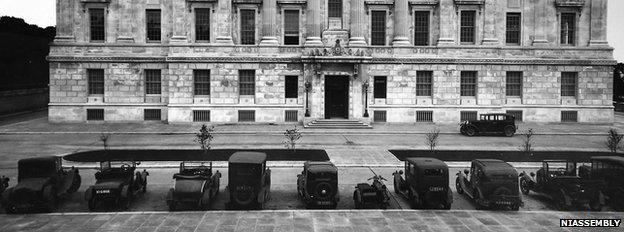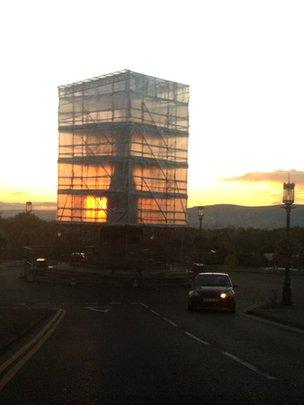Stormont: Construction of seat of power is marked
- Published

An exhibition on the construction of Stormont is being held in the Northern Ireland Assembly
The folks on the hill have been there for 80 years, but Northern Ireland's parliamentarians are getting ready to mark the construction of Parliament Buildings.
Initially it was planned to combine parliament, government and court buildings on one site and there was debate as to whether a location outside Belfast's city centre was befitting of a parliament.
Nevertheless, three sites were shortlisted - Orangefield, Belvoir Park and Stormont and after approval was granted to site the parliament outside Belfast, Stormont Castle and its estate of 235 acres were bought for £20,000.
Preliminary plans were drawn up in 1922 and site preparation started the following year. In 1925, cost restrictions saw plans for a tower and two office blocks abandoned.
Work on the main superstructure started in 1928 and it was officially opened in 1932 by the Prince of Wales, later King Edward VIII.
The building itself was controversial, as was the constitution settlement dividing Ireland.
Unionists, led by Prime Minister James Craig sought a "stately" building to enhance the status of the new Northern Ireland government.
The Irish nationalist leader, Joe Devlin, who was opposed to the new constitutional arrangements, described the parliament as a "palace in no-man's land".
Stormont itself was designed by Sir Arnold Thornley, from Liverpool.
A photographic history of the construction is on display at Stormont. The current speaker of the house, Willie Hay, said he wanted visitors from right across Northern Ireland to see the building for themselves.
"I keep saying to people that this is the people's building so I think that's vitally important," he said.
"If the people aren't out there voting for politicians we wouldn't be here in the building, so it's very important this is the people's building and that we look at getting new people into the building.
He said there had been a lot of work behind the scenes to bring the exhibition together.
"This was never about the politics of the building over those 80 years, this was about telling the story of the construction of the building," he said.
"This was a huge building for that time period. We didn't have the modern technology that we have today, for example, we had a steam shovel that dug the foundations. There was a mini railway that transported materials through the site.

Refurbishment work has been taking place on Carson's statue
"I think when you look at all of that, you will have to say it's a fine building and one worth coming to see."
Sinn Fein assembly member Barry McElduff said that perceptions of the building had changed.
"I would have thought of it as a building where, maybe, in one of those rooms somebody would have signed an order to intern without trial an uncle or two of mine," he said.
"So it would have been that degree of alienation, an oppressive place where it reflected single unionist rule, but now it's different and it's a brilliant working environment in terms of the estate and the building."
He said that some republicans were still not comfortable with Stormont.
"They step back from it and don't implicate themselves by coming here," he said.
"It still has some political baggage in that sense of a negative nature but I'm all for opening up the doors of Stormont, let them see around them, it's their building."
Another piece of refurbishment has also been taking place - a clean-up of the statue of the unionist leader Edward Carson outside the building.
Mr McElduff said this was one of the aspects of Stormont that his party wants to change.
"Carson's statue and Craigavon's statue and tomb. All of these things identify this place with belonging to one tradition," he said.
"We will test through the Assembly Commission, we will test that will for change.
"One small thing that could happen in the short term, without changing too much, is that we could put a hurling stick, a hurley, in Carson's hand because he did play hurling for Trinity College after all."